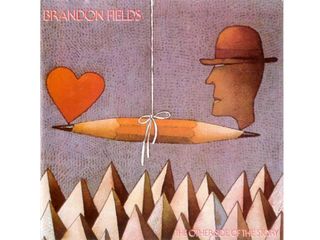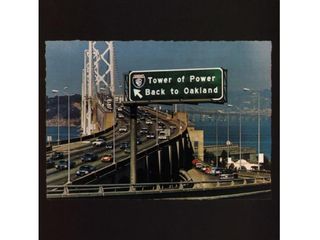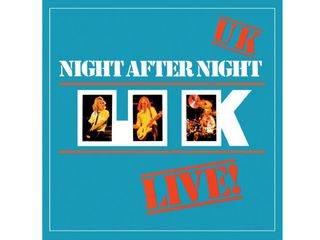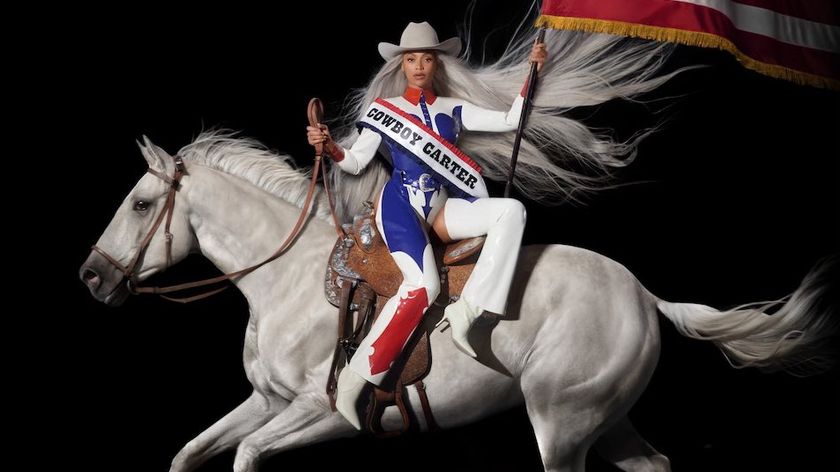
Glen Sobel picks 10 essential drum albums
"For me, a great drum album is a game-changer in some way," says Alice Cooper drummer Glen Sobel. "You know it when you hear it: ‘Wow, something’s going on here! I’ve really got to sit down and listen to this.’ Albums that fit into this category can really have an effect on your playing. They make you realize that there’s a whole new world out there that you have yet to explore."
Like many sticksman of his generation, Sobel's first drum heroes were John Bonham and Neil Peart. But while most budding players were wearing out copies of Led Zeppelin II and Moving Pictures, Sobel gravitated towards the live recordings. "Bonham’s Moby Dick drum solo on The Song Remains The Same was a pivotal moment in my life," he says. "And Peart’s solo on Exit… Stage Left just left me speechless, it was so phenomenal. More than anything else, it was those two records that made me want to be a drummer."
However, when compiling his list of essential drum albums, those records he strongly recommends to players of all levels, Sobel omitted his early faves. "Me telling people to listen to Bonham and Neil Peart is almost a cliché," he says. "Of course, you should study those guys."
Rather, Sobel decided to focus on left-of-center choices and forgotten gems – "gateway records," he calls them. "They're the kind of records that lead you to other albums," he says. "You discover a drummer you never heard of before, and then you go out and get everything he did. And then you start talking to other drummers who have discovered them. It's so cool when that happens, and all it takes is that one seminal record to start it off."
Listed alphabetically, the following are Glen Sobel's picks for 10 essential drum albums.

Brandon Fields - The Other Side Of The Story (1986)
“Brandon Fields is a saxophone player, and in the ‘80s and ‘90s he did a lot of records that featured some of the best LA studio and fusion guys. This whole record is Gregg Bissonette on drums.
“I was a student of Gregg’s. He was my mentor when I was about 18, 19 years old, but I had this record before I ever took lessons from him, so I knew what he was about. This record is very much like an ‘80s-sounding fusion thing, but what was cool about it was that Gregg came at it in a rock way. This wasn’t too long before he started playing with David Lee Roth.
“There’s a lot of styles, genres and sub-genres represented here: Latin, funk, odd time, you name it. But it’s got Gregg’s feel all over it. You can tell that this guy can rock as well as do everything else. There’s a drum solo to a song called The Brain Dance, and in drummer’s circles it’s pretty famous. It was transcribed in Modern Drummer. Gregg was doing a lot of what you’d probably call his ‘Gregg-isms,’ so that track is a crash course in his style. To expand your rock playing in some really cool ways, I'd definitely recommend this record to drummers.”

Allan Holdsworth - Secrets (1989)
“If you’re a serious Vinnie Colaiuta, you already own this record. If not, you should pick it up and find out what you’ve been missing. It’s funny how some of the younger players don’t know a guy like Vinnie. I teach at the Musician’s Institute, and when I bring up his name, somebody will say, ‘Oh yeah, he played with Sting.’ And of course he did, but there’s so much more to him.
“This is probably one of the most popular records for true Vinnie Colaiuta fans. It’s brilliant in that it’s so loose yet so together sounding. The first track is called City Lights, and if you just heard that one song, you'd get a good sense of what's going on – so much is packed into it. The interplay between everybody is amazing.
“Vinnie, just being himself, knows when not to ‘be Vinnie.’ He’s a fantastic session player, somebody who can go in and play with so many people, everybody from Faith Hill to Sting to Megadeth. This album is an example of him ‘being Vinnie.’ He gets to really go off, and he's stunning.”

Tony MacAlpine - Edge Of Insanity (1985)
“One of the reasons why this record is special to me is because Tony MacAlpine was my first pro gig. But I was already a big fan, and this is the album that did it for me.
“It’s an important bridge record between fusion and metal. It hadn’t been done too much before then, and it hadn’t been done in quite this way. Steve Smith is the drummer here. He was mostly known for being in Journey at the time. He had his fusion group, Vital Information, but they hadn’t made a big dent in the market yet, not until they did the album Global Beat – that’s an important record, too.
“This record has a lot of hallmarks of metal music, but there’s an improvisational element, too. There’s double bass patterns that are pretty set, but you can tell there’s a lot of interplay and people going off. Billy Sheehan was the perfect bassist to play with Steve Smith here.
"This record was the springboard for a lot that came after it. Tony’s had a lot of great drummers play with him over the years, and so I was honored to work with him when I did.”

Mahavishnu Orchestra - Birds Of Fire (1973)
“This is Mahavishnu Orchestra’s second record, and it features Billy Cobham on drums. It was the first time he ever played double bass, but you can’t tell – he’s already a master in his approach to the setup.
“Killer musicians were in the band. You’ve got John McLaughlin on guitar, Jan Hammer on keyboards – everybody’s just at the top of their game. The record was cut live, so there’s lots of improvisation going on, and the intuition between the players is remarkable. There’s incredible riffs, but nothing sounds planned or forced. The music just seems to happen very naturally.
“There’s one song on the album called Miles Ahead that sounds like what Jimi Hendrix would have played if he were a straight-ahead fusion musician. But Cobham is just a monster here. His playing is so ahead of its time. Along with what he did on his debut album, Spectrum [1973], he raised the bar for what could be done on the double bass.”

Meshuggah - Destroy, Erase, Improve (1995)
“This wasn’t their first record, but it was the one where they really came into their own. They would probably be described as ‘death metal,’ but there are so many elements of fusion and classical in what they do. The guitar player is influenced by Allan Holdsworth – who else is like that in extreme metal?
“Their use of polyrhythms is incredible, and here again, that’s a concept that was explored pretty much in fusion. Cyclical rhythms going over the bar line that make the listener think it’s an odd time, but it’s really in 4/4 – Steve Smith did that, but I never thought an extreme metal band could pull it off. The drummer, Tomas Haake, is a master at it.
“And they keep topping themselves and pushing that concept – it’s remarkable. But this is the record where they started it all. They’re a very inspiring band.”

Return To Forever - Romantic Warrior (1976)
“One of the very first fusion records I ever bought. The drummer, Lenny White, could almost be put into the same category as Billy Cobham. He had a really powerful left hand here – a lot of grace notes going on.
“There’s a track called Overture that says it all. Return To Forever have other records, but nothing will top what they did here. Without knowing it the time I first heard it, it was kind of a precursor to neo-classical rock or neo-classical metal.
“The music was a game-changer. Al Di Meola is doing all of these fast arpeggios and monster riffs – the kind of things that really influenced players like Tony MacAlpine – and Lenny White was right there with him, affecting the changes, pushing the patterns. Very explosive musicianship that turned a lot of people around.”

John Scofield - Blue Matter (1987)
“This is the record where Dennis Chambers was unleashed on much of the music world. He had done some gigs before this, like with George Clinton, but he was still under the radar. It wasn’t until this record and the Buddy Rich Memorial Scholarship Concert that he took part in that people really heard what he could do.
“That concert put him in front of people, but I had a bit of a jump on them because of hearing this record. Dennis took a lot of influences, like Cobham, and he mixed them all up and put his own spin on them. He took everything to the next level.
“He incorporated a lot of what would be called ‘ride-and-hi-hat grooves’ to form some super-charged, powerful funk grooves. He had a right foot that was very, very strong, and it made me want to concentrate more on that part of my playing.
“His interaction with the band is what makes it for me. Scofield wasn’t a super-aggressive, shredding guy; he was more subdued, into textures and things. That kind of style leaves a lot of space for the band, the rhythm section, to open up and show off. You have to know what you’re doing and what the music needs when you have the chance to explore that kind of interplay.”

Tower Of Power - Back To Oakland (1974)
“Drum-wise, if you’re going to start with anything from David Garibaldi, this is the one. Oakland Stroke, the opening track, totally sums up the band. It’s super-charged, super-syncopated funk, but it doesn’t sound forced. I don’t like it when a band sounds like it’s trying too hard to do something. Tower Of Powered didn't try too hard. Their music just kind of exploded.
“Garibaldi’s playing on the song Don’t Change Horses (In The Middle Of A Stream) is hard-hitting and powerful, but it just seems to flow. It’s his own kind of sound and style, and it still holds up today.
“He made me see that there was a lot more to drumming than just the backbeat, the two-and-four. If you listen to the song Squib Cakes, you hear it and you just say, ‘I’ve got to learn that!’
“And the other guys are solid, too. You’ve got Rocco Prestia on bass. You listen to him, and you say to yourself, ‘I want to play with a guy like him, because he will make me up my game.’”

Pat Travers - Live! Go For What You Know (1979)
“It’s a great mix of hard rock and funky, heavy blues, but there's a slight bit of fusion and progressive rock, some cool odd-time stuff. Tommy Aldridge is the drummer, and his playing is very busy on this record. The rhythmic interplay between him and Mars Cowling on bass is something I’d never heard before.
“It’s heavy, but there’s a funky kind of urgency going on. I wore this record out. I think a lot of kids today probably have their favorite metal drummers, but they should go back and check this one out. Tommy is an important guy to listen to. He influenced a lot of drummers. I know he had a big impact on my playing.”

UK - Night After Night (1979)
“Different people had been in UK, but this album has the line-up that people seem to talk about the most: Eddie Jobson, John Wetton and, of course, Terry Bozzio on drums. It’s all super-charged, super-progressive and utterly mind-blowing.
The song Caesar’s Palace Blues is probably the most well known on the record. It’s Terry getting to do his thing. I’m sure it was many people’s first exposure to him, even though he had played with Zappa and the Brecker Brothers before this.
“The song Presto Vivace is about a minute long, and it’s a masterpiece. It sounds like every bar is a different time signature. I never figured out how to play it – I didn’t even try. It’s one of those tracks that made me say, ‘Wow! This is the highest level of musicianship.’
“There’s lots of odd times on this record, and what I like about it is it all makes sense. Some bands play in odd times, and it’s like they’re trying too hard to be clever – the music is confusing. It’s better when the riffs and the music just flows, like it does here.”

Joe is a freelance journalist who has, over the past few decades, interviewed hundreds of guitarists for Guitar World, Guitar Player, MusicRadar and Classic Rock. He is also a former editor of Guitar World, contributing writer for Guitar Aficionado and VP of A&R for Island Records. He’s an enthusiastic guitarist, but he’s nowhere near the likes of the people he interviews. Surprisingly, his skills are more suited to the drums. If you need a drummer for your Beatles tribute band, look him up.

"Reggae is more freeform than the blues. But more important, reggae is for everyone": Bob Marley and the Wailers' Catch a Fire, track-by-track

“Part of a beautiful American tradition”: A music theory expert explains the country roots of Beyoncé’s Texas Hold ‘Em, and why it also owes a debt to the blues

"Reggae is more freeform than the blues. But more important, reggae is for everyone": Bob Marley and the Wailers' Catch a Fire, track-by-track

“Part of a beautiful American tradition”: A music theory expert explains the country roots of Beyoncé’s Texas Hold ‘Em, and why it also owes a debt to the blues









